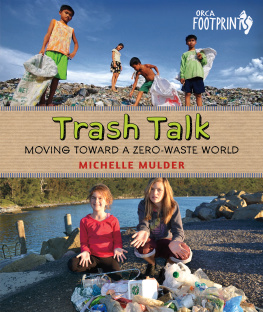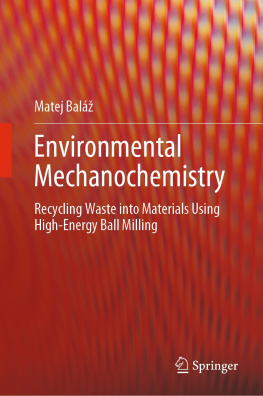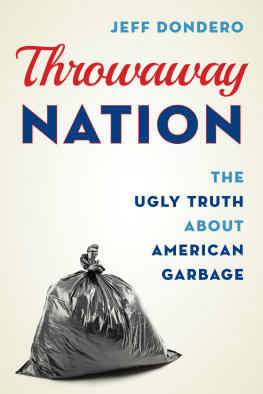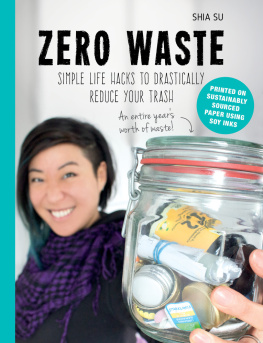Strasser - Waste and want: a social history of trash
Here you can read online Strasser - Waste and want: a social history of trash full text of the book (entire story) in english for free. Download pdf and epub, get meaning, cover and reviews about this ebook. City: New York;N.Y, year: 2000, publisher: Henry Holt and Co., genre: Home and family. Description of the work, (preface) as well as reviews are available. Best literature library LitArk.com created for fans of good reading and offers a wide selection of genres:
Romance novel
Science fiction
Adventure
Detective
Science
History
Home and family
Prose
Art
Politics
Computer
Non-fiction
Religion
Business
Children
Humor
Choose a favorite category and find really read worthwhile books. Enjoy immersion in the world of imagination, feel the emotions of the characters or learn something new for yourself, make an fascinating discovery.

- Book:Waste and want: a social history of trash
- Author:
- Publisher:Henry Holt and Co.
- Genre:
- Year:2000
- City:New York;N.Y
- Rating:5 / 5
- Favourites:Add to favourites
- Your mark:
- 100
- 1
- 2
- 3
- 4
- 5
Waste and want: a social history of trash: summary, description and annotation
We offer to read an annotation, description, summary or preface (depends on what the author of the book "Waste and want: a social history of trash" wrote himself). If you haven't found the necessary information about the book — write in the comments, we will try to find it.
Strasser: author's other books
Who wrote Waste and want: a social history of trash? Find out the surname, the name of the author of the book and a list of all author's works by series.
Waste and want: a social history of trash — read online for free the complete book (whole text) full work
Below is the text of the book, divided by pages. System saving the place of the last page read, allows you to conveniently read the book "Waste and want: a social history of trash" online for free, without having to search again every time where you left off. Put a bookmark, and you can go to the page where you finished reading at any time.
Font size:
Interval:
Bookmark:


The author and publisher have provided this e-book to you for your personal use only. You may not make this e-book publicly available in any way. Copyright infringement is against the law. If you believe the copy of this e-book you are reading infringes on the authors copyright, please notify the publisher at: us.macmillanusa.com/piracy.
Contents
For Bob,
and in memory of Susie Huston
Toward a History of Trashmaking
At first the new scavenger is filled with disgust and self-loathing, writes Lars Eighner, describing Dumpster diving in his 1993 memoir of American homelessness. That stage passes with experience. The scavenger finds a pair of running shoes that fit and look and smell brand-new. He finds a pocket calculator in perfect working order. He finds pristine ice cream, still frozen, more than he can eat or keep. He begins to understand: People throw away perfectly good stuff, a lot of perfectly good stuff. To the Dumpster diveras to the scavengers who live on the Mexico City dump, the ragpickers who fascinated bohemian Paris, and the Chinese immigrants who foraged on San Francisco streets at the end of the nineteenth centurywhat counts as trash depends on whos counting.
Daily experience suggests that trash is a dynamic category. Objects move in and out of it in many ways besides Dumpster diving. The torn sweater, consigned to the giveaway pile, is restored to service by a friend who knits. The impossibly shabby cabinet, already repainted twice, ends up on the curb; a neighbor takes it to his basement, where it holds paint cans for twenty years until somebody strips the finish, rubs in some oil, and carries it up to the living room. The grotesque lamp, given away as the yard sale winds down, comes into fashion five years later; suddenly its worth a mint.
What do we throw out? Like people in other cultures and at other times, we in contemporary developed societies rid our living spaces of corpses and bodily wastes. Like others, we consider rotting and rancid organic material impurethough the line between rancid and not, edible and spoiled, pure and impure is a matter for cultural and personal debate. So is the one between usable and worn-out, but every culture leaves some broken pottery and implements, which fill the trash dumps archaeologists study. People get rid of excess: We can eat only so many of the zucchini in the garden, we lack storage space for our grandmothers crocheted bedspreads. Recognizing value in these things, we may give vegetables to the neighbors or hold an estate sale. Throughout the world, harvest and funerary customs include ways of dealing with excess that keeps it out of the trash.
We of the developed nations at the turn of the millennium have additional reasons for throwing things outreasons that, while not entirely new, operate on an unprecedented scale. More often than people in less developed economies, we discard stuff simply because we do not want it. We buy things devised to be thrown out after brief use: packaging designed to move goods one way from factories to consumers, and disposable products, used one time to save the labor of washing or refilling. In addition, vast numbers of us declare clothes and household goods obsolete owing to changing tastes. Historians have described a consumer revolution that brought fashion to the wealthy in eighteenth-century Europe and America, but until the second half of the twentieth century, the great majority of people even in the most developed countries could not afford to discard clothes or household furnishings until they were worn out. Even then, many people made money from selling their rags and scraps. Similarly, people who could afford it have traded up for a sharper knife or a better timepiece throughout the history of technological innovation. Now watches, too, are styled for obsolescence, and the incessant proliferation of musical-reproduction formats and personal-computer technologies sometimes makes expensive equipment obsolete before it hits the market. These habits of disposing of out-of-style clothes and outmoded equipment promote a veneration of newness not widespread before the twentieth century, filling Dumpsters with perfectly good stuff that is simply not new anymore, stuff the owner is tired of.
* * *
If we focus on the categorizing process that defines trash, our attention will be drawn away from the rubbish heap and concentrated on human behavior. Trash is created by sorting. Everything that comes into the end-of-the-millennium homeevery toaster, pair of trousers, and ounce of soda pop, and every box and bag and bottle they arrive ineventually requires a decision: keep it or toss it. We use it up, we save it to use later, we give it away, or at some point we define it as rubbish, to be taken back out, removed beyond the borders of the household. As everyday life and ordinary housework have changed over time, so has this process of defining what is rubbish, as well as the rubbish itself, the contents of the trash.
Nothing is inherently trash. Anthropologist Mary Douglas resurrects and analyzes the common saying (sometimes attributed to Lord Chesterfield) that dirt is matter out of place. Dirt is relative, she emphasizes. Shoes are not dirty in themselves, but it is dirty to place them on the dining-table; food is not dirty in itself, but it is dirty to leave cooking utensils in the bedroom, or food bespattered on clothing; similarly, bathroom equipment in the drawing room; clothing lying on chairs; out-door things in-doors; upstairs things downstairs; under-clothing appearing where over-clothing should be, and so on. Sorting the dirty from the cleanremoving the shoes from the table, putting the spattered clothing in the washing machineinvolves systematic ordering and classifying. Eliminating dirt is thus a positive process.
Sorting appears everywhere in the historical evidence about trash. Attend to the following rules, Lydia Maria Child told readers of the 1835 edition of The American Frugal Housewife, explaining how to sort food waste. Look frequently to the pailsthe slop pails, which held pig feedto see that nothing is thrown to the pigs which should have been in the grease-potwhere fats were saved for cooking and soapmaking. Look to the grease-pot, and see that nothing is there which might have served to nourish your own family, or a poorer one. An article about street children published in the Atlantic in 1869 describes groups of girls, small Cinderellas, sifting ashes in search of unburned coal and the occasional silver spoon. An early-twentieth-century description of a factory that extracted useful products from bones declares that the first operation is that of sorting several women are constantly engaged separating the rags, iron, beefy matter, hoofs, horns, etc. As they are sorted the bones are pushed to the mouth of the crusher. And although he admits to occasional dysentery as a result, Lars Eighner provides instructions for sorting discarded food, useful to the aspiring Dumpster diver. Eating safely from the Dumpsters involves three principles, he writes: using the senses and common sense to evaluate the condition of the found materials, knowing the Dumpsters of a given area and checking them regularly, and seeking always to answer the question Why was this discarded?
* * *
Sorting and classification have a spatial dimension: this goes here, that goes there. Nontrash belongs in the house; trash goes outside. Marginal categories get stored in marginal places (attics, basements, and outbuildings), eventually to be used, sold, or given away. Douglas calls special attention to boundaries and marginsespecially the boundaries of the body and, by analogy, those of the household and the cityas locations for purifying activities. Indeed, disposal takes place in the intersection between the private and the public, the borderland where the household meets the city, the threshold between the male and female spheres of the nineteenth century. (This may explain why men have so often been delegated to take out the trash.) Reporters and fans insist that anything outside the walls of a celebritys house is theirs to look at and keep, and the Supreme Court has ruled that to be so.
Font size:
Interval:
Bookmark:
Similar books «Waste and want: a social history of trash»
Look at similar books to Waste and want: a social history of trash. We have selected literature similar in name and meaning in the hope of providing readers with more options to find new, interesting, not yet read works.
Discussion, reviews of the book Waste and want: a social history of trash and just readers' own opinions. Leave your comments, write what you think about the work, its meaning or the main characters. Specify what exactly you liked and what you didn't like, and why you think so.





